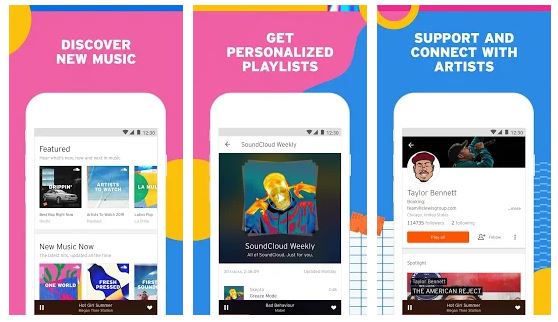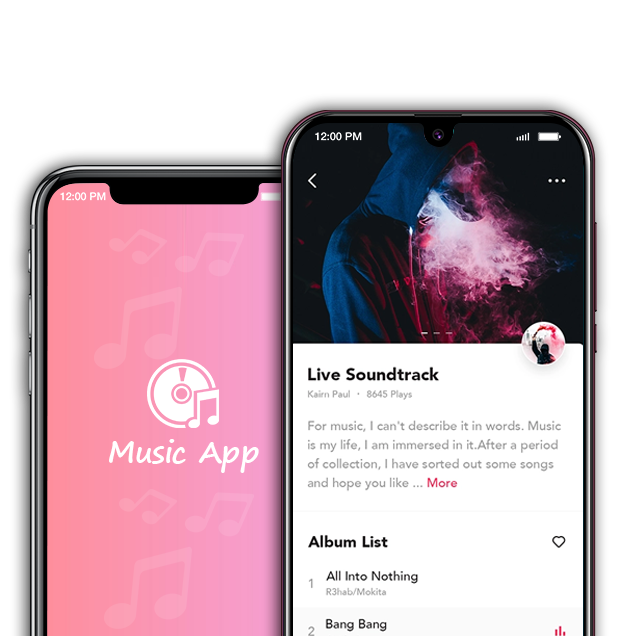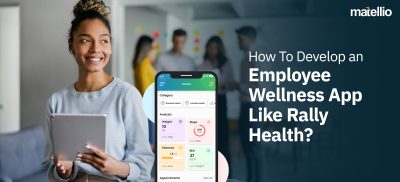
When nothing goes right, turn your life musical…
Feels relateable? After all, that’s what music lovers do. Happy? Music. Sad? Music. Gymming? Music. Traveling? Music… And what not, a combination that can be formed with any feeling. No wonder the music industry has been winning amazing laurels to itself in terms of revenue for the past few years and still counting. Digitalization has, in turn, added superb perks to the musical journey of the listeners as well as the business owners. Benefitting users with on-demand music streaming, on-the-go rendering capabilities, round-the-clock music discovery, and a lot more, the mobile app marketplaces are beaming with an added music streaming app every coming year.
If the idea of on-demand music streaming app development intrigues you too, let’s set out on a journey to learn how it’s done. Here we go!!!
What Digital Music Industry Looks Like, for the Investors?
Actively lead by consumers’ demand for flexible, paid streaming services and on-the-go music consumption, the US music industry one of the most flourishing ones. According to Statista, the average revenue per user is estimated to cross 50.47 USD by the year 2022. Global digital music has generated over 2.35 billion USD through the downloads itself while touching a figure of 11.44 billion USD through streaming.
Supporting the trends, research by XappMedia highlights the following cases:
- Internet radio accounts for 79% of the music listening time
- Majority of internet radio listeners (over 95%) access the services via mobile devices
- 67% of all the music listeners access streaming services weekly
Who are the Music App Market Leaders?
With over 48.9 million mobile-only users, Apple Music tops the list of most popular music streaming services in the USA, followed by names like Pandora Radio and Spotify.
Top 5 Music Streaming Apps
1. Apple Music

- Stream over 50 million songs straight from Apple Music catalog
- Download favorite music to the smartphones and carry it anywhere
- Create custom playlists
- Automated playlist creation based on users’ listening history
- Create profiles to share playlists, music, etc. with the followers
- Personalized recommendations updated daily based on the music you love
- Get exclusive access to content like documentaries on favorite artists, concert films, and original TV shows
- Listen to your favorite artists and DJs on Beats 1, live, or on-demand
- Available on Google PlayStore as well as AppStore
2. Pandora Radio

- Implements advanced algorithms to curate custom radio stations
- Custom music recommendation based on music preferred by the user in the past
- Available in paid as well as a freemium version
- Personalized music experiences evolving with user’s music tastes
- Search for your favorite artists, songs, or genres to create a customized station
- Download music for offline listening
- High-quality audio that streams ad-free in the premium version
- Available on Google PlayStore as well as AppStore across the USA
3. Spotify

- Unlimited access to global music and podcasts
- Discover music based on personal taste like favorite artists, albums, and genres
- Create custom playlists based on favorite songs
- Explore tailor-made playlists and personalized music recommendations according to your mood
- Download music for offline access
- Available for Android and iOS users
4. Google Play Music

- Powered by Google
- Offers millions on songs and thousands of playlists
- Radio-based on songs, artists, and albums curated by experts
- Music recommendations based on taste, activity, mood, location, etc.
- Free storage and streaming for as many as 50,000 songs from the on-device collection
- Unlimited music access is available on the web, Android, and iOS.
5. Sound Cloud

- Boasts of being the world’s largest music and audio streaming app with over 150 million tracks
- Curated music based on preferences and listening trends
- Discover music from favorite genres
- Connect and interact with popular artists
- Create personalized playlists for parties, workouts, etc.
- Take your collection offline with the premium version
- Available on PlayStore and AppStore
Steps to Create a Music Streaming App
On-demand music streaming app development is not a cake walk. Instead, you need to take into account multiple things before you finally venture into the arena. Let’s discuss these things one-by-one to have a clearer view.
Step 1: Decide the Type of Music Streaming App
What type of app do you want to develop? Of course, music streaming it is. But are you aware, there are sub-categories to it? Most of our friends are not accustomed to it. Let’s get to know these categories first:
1. Music Library
What do you find in a book library? Of course, unlimited access to books of various genres, by large author community, apparently at the terms and conditions of the library owners. That’s exactly what music library apps offer, in corresponding terms. These apps function through server-based music storage and provide users with access to the same.
2. Cloud Storage
These apps allow the consumers to store their songs over the cloud and access the same from any location, at any time instant.
3. On-Demand or Interactive Music Streaming
On-demand or interactive music streaming apps offer users a vast database of tracks to explore, discover, and listen. Some of the famous names in this arena are Spotify, Tidal, Deezer, Apple Music, SoundCloud, Google Play Music, etc.
4. Radio Station or Non-interactive Streaming
Radio station apps serve users who are exploring alternatives to conventional radio and broadcasting apps. One of the key differences is that the latter allows users to skip the track if the need be. Powered by robust algorithms that work in the background, these apps are capable of curating music suggestions for the users based on their preferences. Some of the popular examples of such mobile apps include Pandora Music and iHeart Radio.
Step 2: Features that Form Heart of the Music Streaming Apps
No matter what type of music app you want to develop, there are some core features that you can’t afford to miss. Let’s check them out here:
1. Massive Music Library, (OBVIOUSLY)
Well, having an extensive music library is the much-needed boost to your on-demand music streaming mobile app. Make sure you incorporate music from all the genres and user tastes.
Here are four crucial questions that can help you out:
What should I Offer?
Well, you don’t want to end up into legal troubles, and so, the answer is clear licensed music.
What should I use to Store the Data?
For this, you would need a cloud-based server that comes with Content Delivery Network (CDN) like Amazon AWS.
How will I stream Music To the Users?
Okay, storage is one part and to help the users with flawless accessibility to that storage is another. Efficient information transfer from servers to the users will require choosing the most appropriate streaming protocol.
Which format would make it most suitable for storing music?
Music storage can be done using an array of formats including OPUS, MP3, VORBIS, AAC, FLAC, etc. Choosing the best-suited format depends on streaming quality. Probably knowing what popular apps employ, can help you out. Tidal uses Jay-Z while providing full support to FLAC, ALAC, and AAC. On the other hand, Pandora makes use of AAC and Spotify employs Vorbis.
2. Registration
Registration is the key to offer a highly personalized experience when it comes to on-demand music streaming application development. In other words, the primary goal with this section of the application is to offer users with a clean interface that analyses user’s preferences without bombarding them with lots and lots of questions. For instance, Pandora and Spotify keep track of the user’s location and age in order to curate tracks that are popular in that location among the users of that particular age group. While some apps ask a direct question during the registration, some of them also provide social sign up options to make the task easier.
3. Search and Discover Tracks
Track discovery is another must-have feature when it comes to on-demand music streaming app development. Enables users to search for songs, playlists, genres, artists, and albums in the easiest possible way. Additionally, you can incorporate options for the users to search for songs based on mood and activity similar to Spotify and Pandora.
4. Custom Recommendations
Why users opt for Pandora or Spotify over Apple Music? Credits to Apple Music’s poor recommendation engine. You don’t want to end up adding onto the list that Apple Music lies in. Thus, supporting your on-demand music app development with a strong recommendation engine is what you need here. Suggest tracks to the users based on their taste matrix garnered through an efficient mechanism.
5. Music Arrangement
This primarily refers to categorizing music by sections, genres, and activities. While you can enable users to create custom playlists, you can also present category-wise listing wherein songs are segregated based on familiar genre, artists, activities, etc. So next time users hit the gym or drive on their way back home, all they have to do is browse through an easily accessible category and let the music play.
6. Playlists
Offer your users with a wide array of playlists that make it worth the download. Allow them to create custom playlists that resonate with their taste and moods or favorite albums.
7. Skip/ Replays
Let’s accept it: We cannot always listen to certain tracks for any reason, and if there’s an app that forces you to do the same, you don’t really enjoy the music. That’s pretty much simpler to understand the importance of “Skip/ Replay” feature in the app. Let you users to enjoy the music playlist the way they want to be and of course, skip the parts that they don’t really want in.
8. Artists-only Playlists
This music app feature lets you listen to your favorite artists without compromising on quality. One can either enter the artist’s name in the search bar and reach to the curated playlist by specific artists, or browse through the artists list for the same.
9. Crowd Favorite Music
What’s on top of user’s mind today- welk, let’s listen that out. This is precisely what this feature brings for you. You can listen to the songs that has been topping the charts for quite sometime and has been most liked by the other listeners.
10. Newly Released
Browse and discover newly released songs easily and let your users do the same with this initiative add-on to the feature list.
Step 3: Choose the Features You Want to Add as a Part of Advanced Options/ Premium Versions
While you laid out MVP-specific features in step 2, now it’s the time to come up with the bonus that your users can avail. After all, adding new features is a must when you have to fight competition with the giants like Apple Music, Pandora, Spotify and more.
Let’s trace down some of these features:
1. Offline Access
Yes, online song access is what on-demand music streaming app development targets to, but users demand an offline mode, and they are important. No one wants to be stuck around with an incomplete song just because they entered a low connectivity zone. Clearly, why this is a great feature you can add to your application. While some of the significant on-demand music streaming apps provide song download functionality as a part of the paid version, some of them allow you to play songs in offline mode by storing them in the device’s cache.
2. Push Notifications
Music lovers want to stay connected to their favorite artists, or probably a new addition to the genre they like, a new album release, an upcoming event, and many more things alike. Thus, push notifications take you closer to the users by fulfilling their requirement for you.
The task is simple; they want to stay informed, keep the excitement alive by sending push notifications.
3. Social Media Integration
This provides a win-win perk to the app users as well as the owners. While it enables the consumers to share a newly found track or favorite ones with their social community, social media integration acts as a free promotional tool for the owners. Thus, missing out on this is a big NO.
4. Event Calenders
Targetting the ones who love to keep an eye on upcoming concerts and events, this fun feature will earn you some brownie points. Help them track down tour dates and club meets coupled with concerts and other events.
5. Upload Music
Following SoundCloud’s model, you can let your users upload their track to the app’s server. However, you must also take care of handling the licensing wisely.
Step 4: Choose the Monetization Model
Trends have made it quite apparent that users don’t shy away from paying for music streaming services. Therefore with the right mix of features and services, you can really make it big in the area of on-demand music streaming apps. You can choose from one of the following proven methods to layout the monetization plan for your app:
1. Freemium
Serving as the most popular way to monetize the streaming application, this model enables users with unlimited access to the tracks while charging them for added services.
2. Ads
Traditional app monetization strategy, this would require you to gain profits through ads. In case the users don’t want their music experience to be interrupted by commercials, they can upgrade to the paid version.
3. Paid Plans
This plan takes away the liberty of using the app for free from the user. And thus, if you want to monetize your app via the third option, you can establish your trust in the user by providing a free trial for a certain period and then extending it.
Step 5: Handle the License Needs
On-demand music streaming app development also needs you to handle the license requirements pertaining to the tracks. Ending up into legal issues will not even be the last thing that you would want to encounter in your journey. Talking to the USA market, the license is recognized as Public Performance Rights and is handled by The American Society of Composers, Authors, and Publishers or Broadcast Music Incorporated.
Step 6: Put the Findings into Action with On-demand Music Streaming App Development
Done through step 1 to step 4, you are all set to venture into on-demand music streaming app development. All you now need is the company of expert business analysts who can help you harness maximum potential from your idea and skilled mobile app developers who can implement those findings.
Signing Off
Excited to finally launch your own on-demand music streaming app? And once you are through with your homework, the excitement will increase further. Meanwhile, how about you visit us and ask for an estimation free of cost? With years of industry experience and technical know-how, our web developers and mobile app development teams have crafted brilliant solutions for diverse verticals. Our clients, coming from various geographical areas and business setups, have been really impressed by our ability to go an extra mile to ensure customer delight. Know for yourself, throw us a line and let’s innovate together!!!






